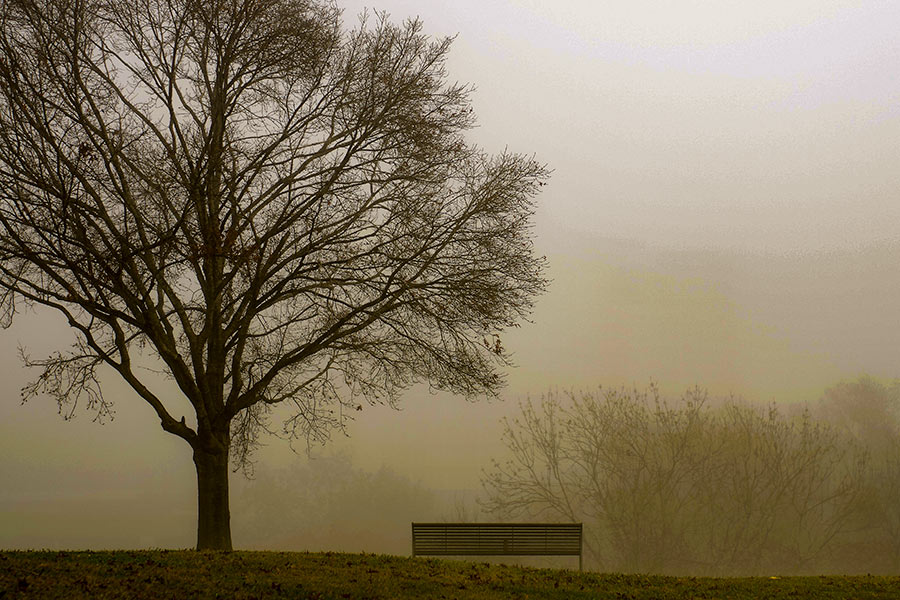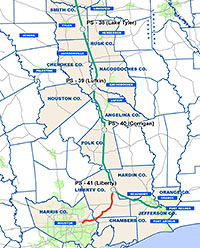THE TIME MY BROTHER AND HIS FRIENDS ALMOST BLEW UP A GAS PIPELINE IN THE BAYOU  One Houston summer in the early 1960s: “My brother and his friends were playing, pretending they were WWII soldiers and they were running around shooting fake machine guns and then they would go over and jump in the bayou pretending it was a foxhole. And I went over and I heard them talking . . . they were going to build their own bomb. And I told them you know you better not do that. . . . The next thing I know I see them in the garage and they’ve got a bunch of my dad’s leftover firecrackers and they’re splitting them open and pouring them into this big prescription bottle. I tried to find my mother. And she ended up being next door. When I ran next door I was standing in the backyard and I heard this loud boom and looked at where the explosion came from and it was right where my brother and his friends had been playing. I heard sirens in the distance and a helicopter started flying real low over the pipeline. . . . Shortly after that there was a knock at the door and it was the police. . . . they said that the magnitude of this explosion had blown an almost-6-ft.-deep hole right above the Shell gas pipeline [that ran along the bayou] and it could have blown up our whole neighborhood had it been a little bit more than that.” [Texas Standard] Photo: Adam Baker [license]
One Houston summer in the early 1960s: “My brother and his friends were playing, pretending they were WWII soldiers and they were running around shooting fake machine guns and then they would go over and jump in the bayou pretending it was a foxhole. And I went over and I heard them talking . . . they were going to build their own bomb. And I told them you know you better not do that. . . . The next thing I know I see them in the garage and they’ve got a bunch of my dad’s leftover firecrackers and they’re splitting them open and pouring them into this big prescription bottle. I tried to find my mother. And she ended up being next door. When I ran next door I was standing in the backyard and I heard this loud boom and looked at where the explosion came from and it was right where my brother and his friends had been playing. I heard sirens in the distance and a helicopter started flying real low over the pipeline. . . . Shortly after that there was a knock at the door and it was the police. . . . they said that the magnitude of this explosion had blown an almost-6-ft.-deep hole right above the Shell gas pipeline [that ran along the bayou] and it could have blown up our whole neighborhood had it been a little bit more than that.” [Texas Standard] Photo: Adam Baker [license]
Tag: Pipelines
PIPELINE PROTESTERS LEAVE FREEZING N. DAKOTA, HEAD TO TEXAS TO CAMP Meanwhile, in Alpine: Several groups of environmental activist-types are currently setting up a series of long-term protest camps along the planned route of the Trans-Pecos Pipeline, which would send natural gas to Mexico from near Ft. Stockton by crossing beneath the Rio Grande. Like the Dakota Access pipeline (which the Army Corps said earlier this month it’s gonna try to reroute),  the Trans-Pecos is another Energy Transfer Partners project — though the company was already running into opposition in the region long before the Dakota protests made the national news, from what Rachel Monroe describes as an unlikely coalition of “archaeologists, McDonald Observatory astronomers, hippies, and ranchers.â€Â The 1st camp was to have opened yesterday near Alpine; David Hunn writes this week that a handful of the same folks from the Dakota protests have already arrived in the region, and that 2 more camps are planned to open early next year, in the ghost town of Casa Piedra (near the edge of Big Bend Ranch State Park) and Toyahvale (home to Balmorhea State Park and San Solomon Springs — and near which Houston-based Apache Corp. is currently planning major drilling operations). [Houston Chronicle, Texas Monthly]
HOUSTON OIL COMPANY WANTS TO BUILD AN ISLAND ON THE ALASKAN COAST Meanwhile, in Prudhoe Bay: Houston-based oil company Hilcorp is seeking permission to construct 23-ac. Liberty Island off the north coast of Alaska by trucking 83,000 cu. yd. of gravel (more than 3 times the volume of the Astrodome) across sea ice to a hole, cut 6 miles offshore above only 19 feet of water. The island would serve as a base for several offshore drilling projects, collectively the first in federal waters off the Alaskan coast. A 5.6-mile undersea pipeline is part of the project. Manmade gravel islands have been in use in the region’s oil fields for decades. [Hilcorp, Associated Press]
UP IN THE PINES TO STOP THE KEYSTONE XL PIPELINE  Three hours north of Houston in Cherokee County, reports Brantley Hargrove, protesters interfering with a 485-mile section of TransCanada pipeline being built to carry diluted bitumen south to refineries on the Gulf Coast faced some resistance of their own: “[An] 18-wheeler bearing a cherry picker to pluck protesters out of trees slowed as it approached a shouting, sign-wielding crowd. Several young men leaped in its path. One fell beneath the truck. The others screamed and pounded the hood with their fists. A deputy rounded the front of the truck and drove the protesters back, loosing clouds of pepper spray. [A 75-year-old woman], standing off to the side of the road, caught a gust of the burning mist.” Separately, TransCanada’s website notes its plans for the Houston Lateral Project (shown in red on the map), a 47-mile spur that will come close to Beltway 8. [Houston Press; Gulf Coast Project] Map: TransCanada
Three hours north of Houston in Cherokee County, reports Brantley Hargrove, protesters interfering with a 485-mile section of TransCanada pipeline being built to carry diluted bitumen south to refineries on the Gulf Coast faced some resistance of their own: “[An] 18-wheeler bearing a cherry picker to pluck protesters out of trees slowed as it approached a shouting, sign-wielding crowd. Several young men leaped in its path. One fell beneath the truck. The others screamed and pounded the hood with their fists. A deputy rounded the front of the truck and drove the protesters back, loosing clouds of pepper spray. [A 75-year-old woman], standing off to the side of the road, caught a gust of the burning mist.” Separately, TransCanada’s website notes its plans for the Houston Lateral Project (shown in red on the map), a 47-mile spur that will come close to Beltway 8. [Houston Press; Gulf Coast Project] Map: TransCanada
THE LUNCHTIME RACKET AT BRADY’S LANDING Visiting the Houston Ship Channel on a promotional “toxic tour” of sites where the air will likely be invigorated once nearby refineries get chugging on the Canadian tar sands headed for Houston through the proposed Keystone XL pipeline, Perry Dorrell stops by the scenic Brady’s Landing Restaurant during lunchtime: “During the evening the restaurant is like many others in the city: bustling with patrons and staff, the parking lot busy with diner traffic. During the day, however, the region’s oppressive noise is invasive and obnoxious; right next door a facility is dry-docking barges and a team of several men operating industrial-grade pressure washers removes barnacles from their hulls. Cranes swing containers to and from foreign freighters, crashing and booming. The warehouses directly across the channel are beehives of activity, with stevedores operating forklifts, shifting and stacking and slamming pallets of material. It was amazing how loud it was, a phenomenon I never noticed in my visits at night to dine. On the other side of the restaurant a steamshovel was loading and unloading a smoking, 200-hundred-foot high brown pile of … something, fertilizer-like in appearance. No accompanying aroma, fortunately. Maybe we were upwind.” [Brains and Eggs; previously on Swamplot]

That proposed underground pipeline linking Houston to the luscious bounty of Canadian strip-mined tar sands will sneak into Houston from the east, and won’t even make it inside Beltway 8, according to this map released by the State Department. The line is scheduled to carry up to 500,000 barrels a day of crude oil to Texas alone — probably more than 8 times as much oil as the successors to the Deepwater Horizon are currently delivering directly to the Gulf of Mexico.
TransCanada plans to stitch the pipeline over the Ogallala Aquifer, which supplies water to part of Texas and much of the Midwest.
The pipeline also would cross more than 30 rivers and streams in Texas and could run underneath the Big Thicket National Preserve, said environmentalists and landowners.
Texas and Oklahoma portions of the 2,000-mile-long Keystone XL pipeline are still under review; this Friday is the deadline for public comment on the draft environmental impact statement released in April.
[TransCanada VP Robert Jones] defended the project, saying pipelines are the safest way to transport oil. The company will use pipe that has been employed safely in Canada for years and bury it 4 feet deep, he said.
Jones also downplayed concerns about Houston’s air quality, saying the Canadian crude is replacing oil from other sources and has not led to changes in the refineries’ pollution permits.
But [Matthew] Tejada, of Air Alliance Houston, found fault with TransCanada’s position. He said the tar-sands crude when refined will emit higher levels of sulfur dioxide, nitrogen oxides and particulate matter into the air than conventional oil.
- Proposed oil pipeline to Texas raises worries [Houston Chronicle]
- Keystone Pipeline Project [TransCanada]
O Houston: In the ephemeral hurly-burly of daily life it’s often too easy to forget just why we’re here.
- Oil Song final animation [Vimeo]
Video: Sharad Patel
COMMENT OF THE DAY: WHAT LIES BENEATH “. . . roads go over top of petroleum pipelines all the time with an agreement & bond to protect them. Citie$, countie$ and large entitie$ do it all the time. The whole of the Woodlands Town Center, including the regional mall there, is built atop a pipeline, which runs alongside the foundation of the Anadarko Tower. Even Lake Robbins, though it’s not at all deep, is on top!” [movocelot, commenting on Comment of the Day: Where the Townhomes Ain’t]

